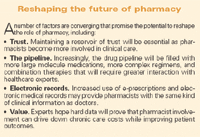Technology drives safety and innovation for retail pharmacy
A growing number of retail pharmacies are looking to automation technology as they expand their businesses beyond lick, stick, and pour.

While pharmacy organizations fret about falling reimbursement rates, many others in the industry remain optimistic about what lies ahead. They see a future with more prescriptions filled as baby boomers age. At the same time more complex medication regimens will require greater involvement of pharmacists. Finally, and most crucially, pharmacy insiders expect data to show that a higher degree of pharmacist interventions can drive down healthcare costs for patients with chronic conditions.
"Pharmacists will take increasingly complex knowledge about medications and help consumers and patients use that knowledge to improve their health," insisted Jonathan Peck, president and senior futurist at the Institute for Alternative Futures. "Consumers trust pharmacists. They are involved in the community, and even as we go from mom and pop stores to chains, retail pharmacy is embedded in the community."
But there is work yet to be done, Burns acknowledged. In order to simultaneously handle the growing number of prescriptions and increasingly complex patient care issues, they must adopt more innovative business models, implement new technologies to handle dispensing, and train pharmacists for more patient-centric care. "The profession is putting a lot of building blocks in place to support that future," Peck argued.
Riding the baby boom wave
Before many pharmacies can tackle medication therapy management or expand into other areas, they face a central problem: how to deal with a growing volume of prescriptions in the midst of an industry-wide labor shortage. "Pharmacy will be John Henryed if it is just lick, stick, and pour," warned Peck. And, in fact, many expect automation to play an increasingly prominent role in the pharmacy, freeing up time for pharmacists to play new roles.
"Technology is a great enabler for our whole pharmacy business, whether at corporate offices, at divisions, or at the stores," argued David Fong, senior VP of pharmacy and family care at Safeway. "There is absolutely a need for technology to help us do a better job and practice more professionally."
New systems are focusing on both the day-to-day pharmacy activities as well as replacing specific functions. "Business processes are getting more scrutiny and there is a need to improve them," said Shabbir Dahod, chairman of SupplyScape, a pharmaceutical supply chain software company. "Pharmacies need to improve the reimbursement timeline and get the cash faster."
Although the growth appears to be gradual, robotic dispensing machines and semi-automated processes are beginning to show up in pharmacies with greater frequency as pharmacists struggle to keep on top of the growing number of prescriptions. "We see an increased focus on automation in retail pharmacy," said APhA's Burns. Interestingly, the reliance on automation appears to be occuring nationwide in rural, urban, and suburban settings.
